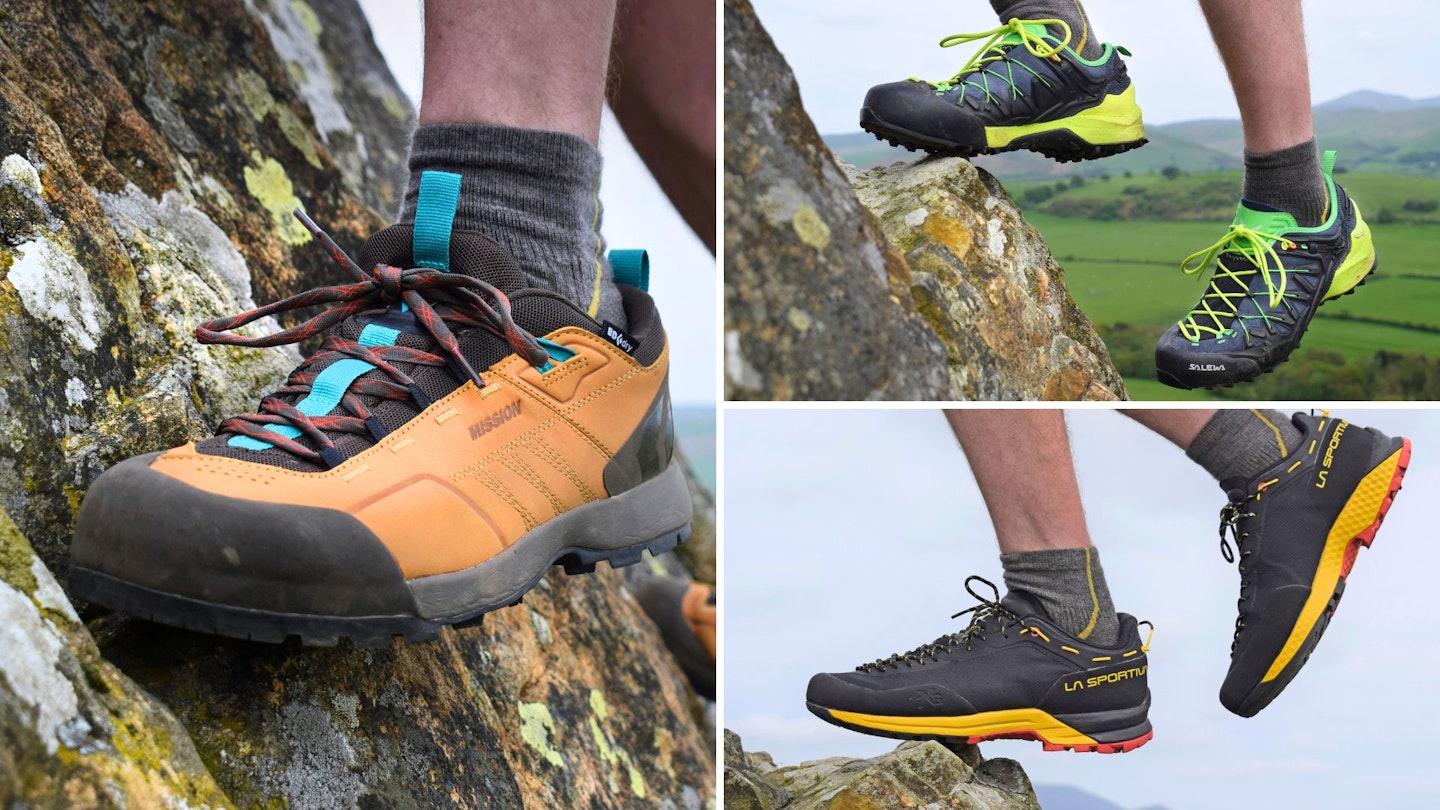In the hiking footwear market, you hear a lot of ‘best of both worlds’ promises. With a decent approach shoe, you really do get the comfort of a hiking shoe and the sticky grip of a climbing shoe.
Designed as a hybrid between these two footwear genres, approach shoes are so-called because historically they were used by climbers on the long walks in (the ‘approach’) to the base of crags or cliffs before a day of climbing.
So the approach shoe was born. But now it’s no longer the preserve of just skilled climbers. Approach shoes are commonly worn by hillwalkers taking on graded scrambles such as Crib Goch, Striding Edge and Aonach Eagach, due to the excellent features they offer.
These include: soft and sticky rubber outsoles for slip-free traction; a precise and narrow fit providing a better ‘feel’ for the terrain; longitudinal rigidity for a more stable connection with the rock; and a climbing zone at the toe to improve performance when ‘edging’ on little rocky ledges and jamming your foot into cracks.
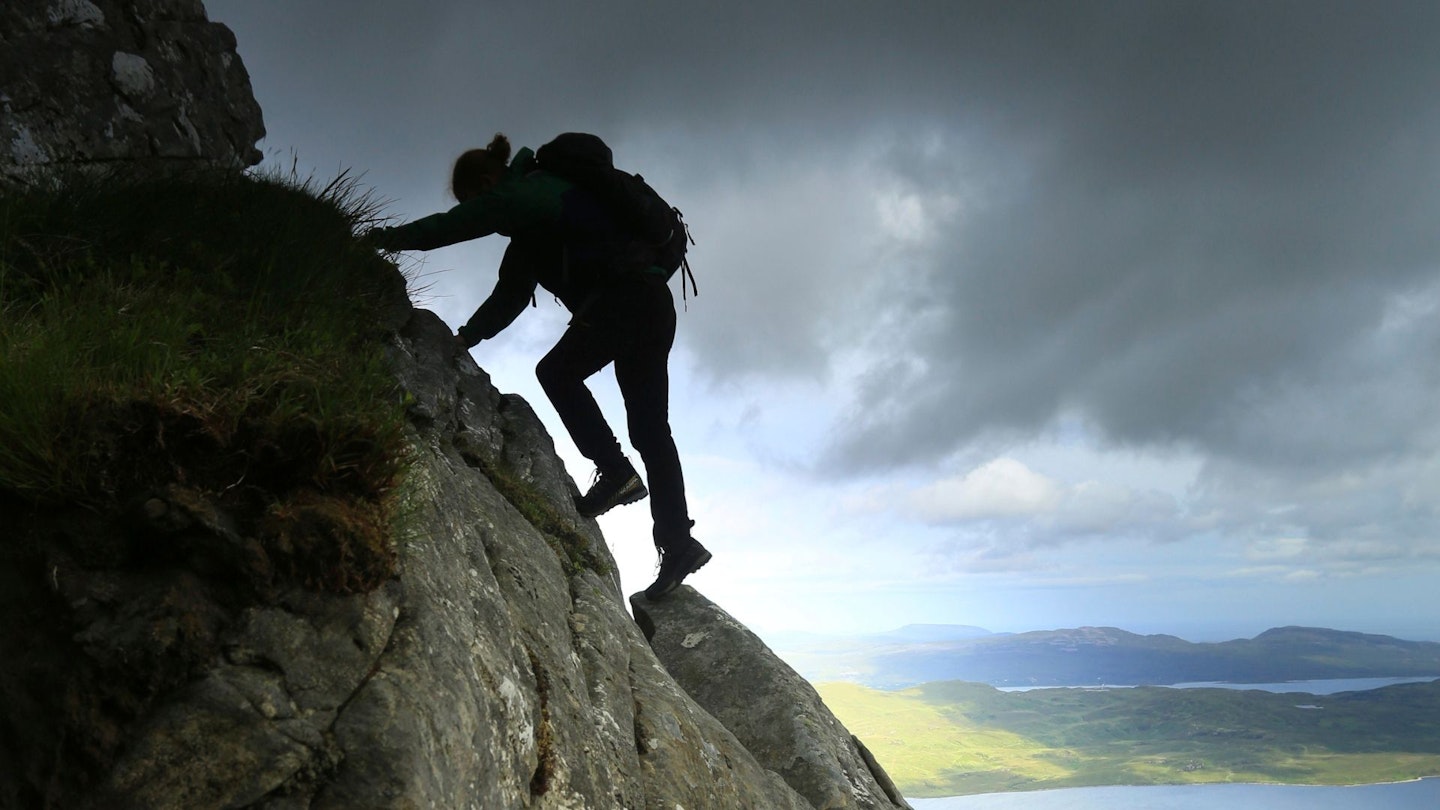
Best approach shoes at a glance:
Best in Test: La Sportiva TX Guide – View on Alpinetrek
Best Value: Salewa Wildfire Edge – View on Alpinetrek
Best for durability: Black Diamond Mission Leather Low Waterproof – View on Black Diamond
Best all-rounder: AKU Rock DFS GTX – View on Alpinetrek
Some approach shoes are more comfy for hiking and less suited to very technical crags; others are less suited to the walk-in but come into their own on the technical terrain. Either way, here are the best approach shoes for your next scrambling adventure.
Best approach shoes in detail:
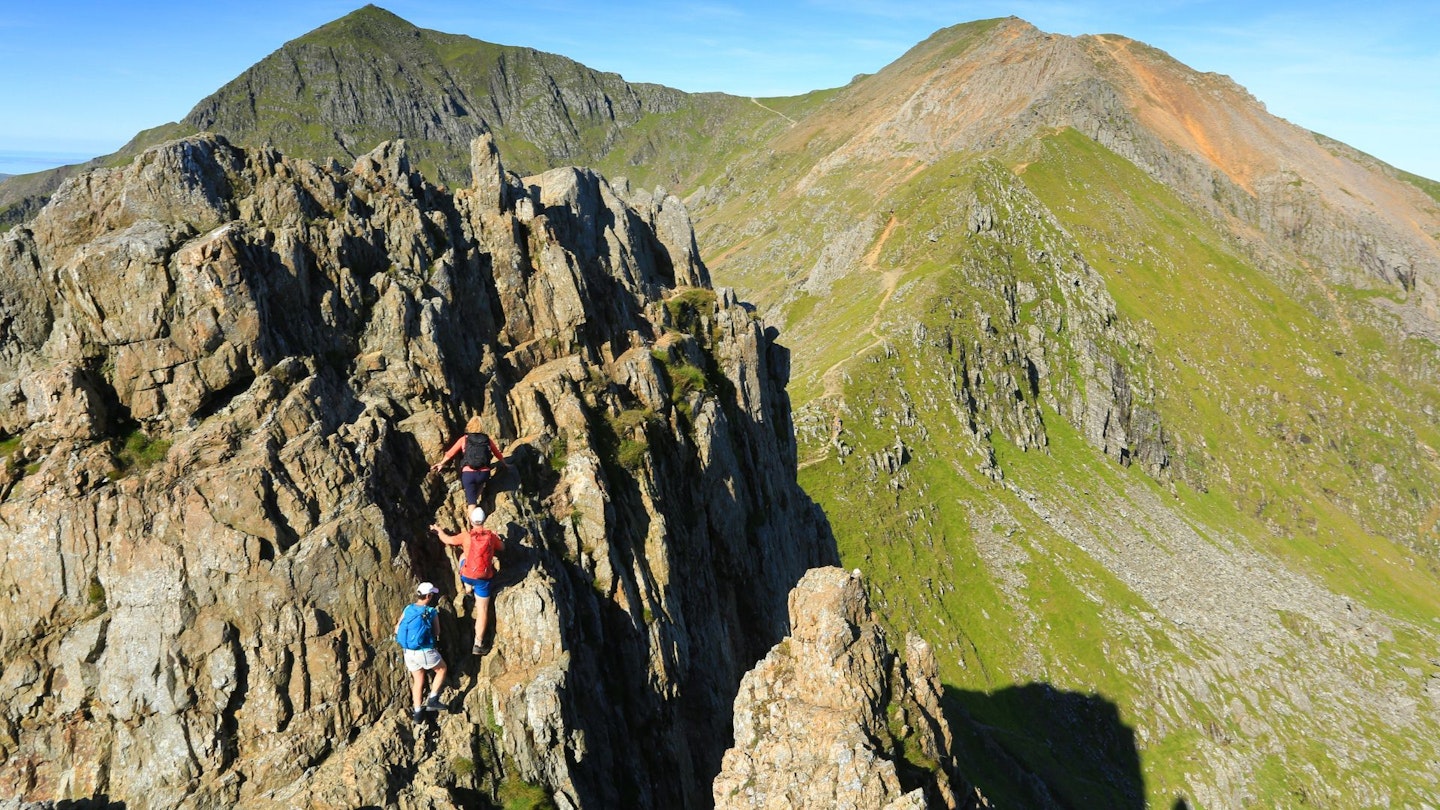
Best in Test
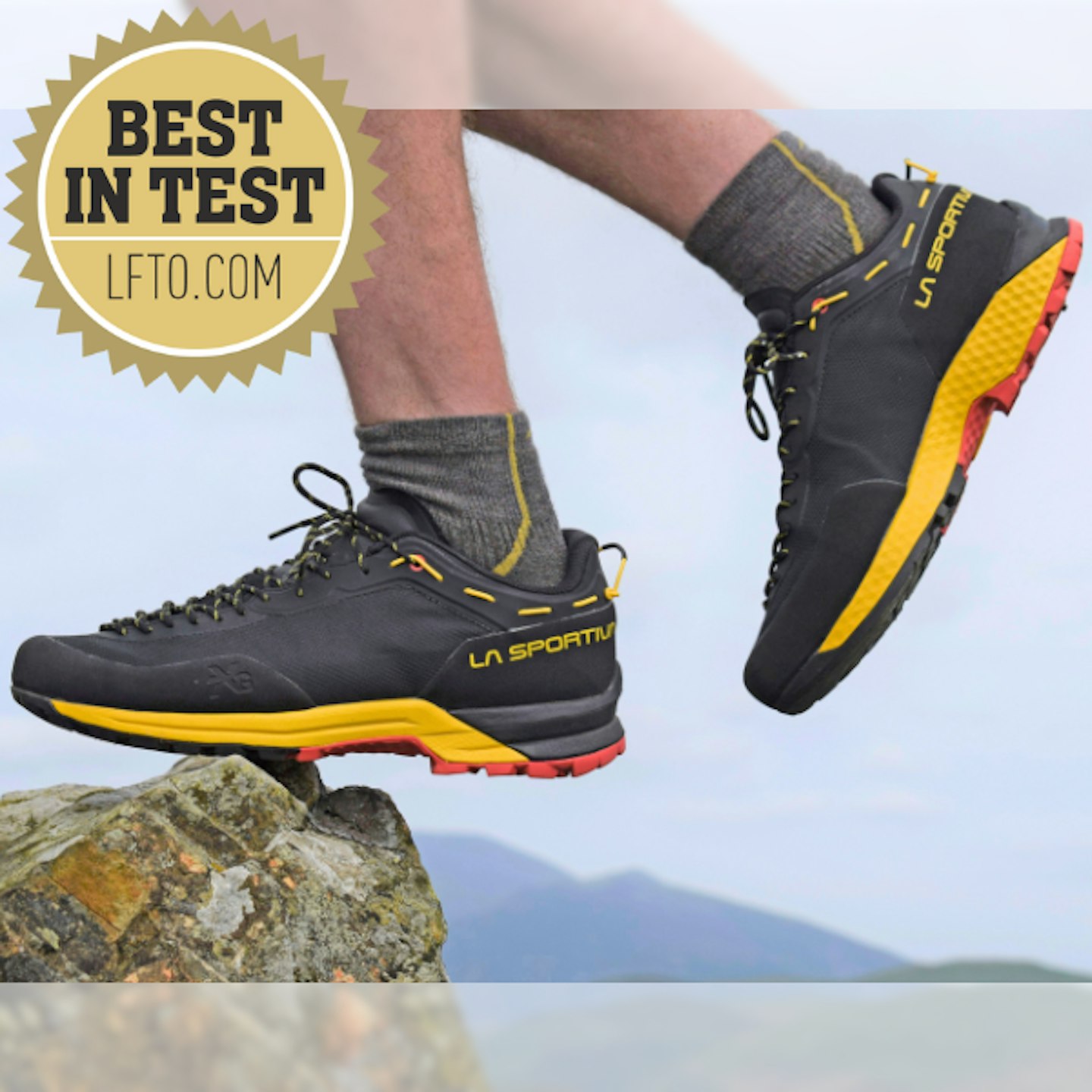 Live For The Outdoors
Live For The Outdoorswww.alpinetrek.co.uk
La Sportiva’s TX range of approach shoes has a longstanding, stellar reputation. Known for its high-end performance, hitting a sweet spot between comfort, protection and technical precision, the TX range is spearheaded by the TX Guide, the “most technical” shoe in the series. The TX Guide is surprisingly lightweight (346g per shoe, the second lightest on test), yet feels stable and supportive in use.
There is a lot of stiffness and rigidity to the platform, ensuring you can securely hold edges using the outsole’s flat climbing zone at the toe. The fit is snug and foot-hugging, with the climbing-style lacing extending all the way to the toe for maximum fit accuracy.
The Vibram MegaGrip and IdroGrip dual compound outsole is designed for a perfect compromise between grip and long-term durability, while the pronounced heel facilitates downhill braking and improved uphill traction. The upper is an abrasion-resistant mesh with TPU reinforcements. A leather version is available.
Downsides are that the toe rand has some flex and give to it, and thus is not as strong as other pairs. The lightweight build may not be robust enough for all. As with many approach shoes, the fit may be a tad narrow for some foot shapes and they’re perhaps too stiff for long-term hiking comfort.
Pros
- Lightweight
- Lots of stiffness for climbing
- Excellent outsole
Cons
- Not the toughest approach shoe
- A bit stiff for longer walks
| Size range | Men's EU37-47.5; women's EU36-42 |
| Weight (per shoe) | 356g (men's 43) |
| Women's version? | Yes |
| Upper | Mesh, internal microfiber reinforcements, TPU external reinforcements, PU-Tech Lite rand |
| Outsole | Vibram MegaGrip |
| Waterproof lining | None |
Best Value
 Live For The Outdoors
Live For The OutdoorsThis approach shoe is highly technical, with innovative technology and a climbing shoe inspired design. It all works excellently, with a precise fit, sure-footed traction and good features.
The Pomoca Speed MTN outsole has a flat toe ‘climbing zone’ with a rigid ‘edging plate’, providing the directional stiffness and solid edging performance you need. The lug pattern provides good all-round grip, and deeper lugs at the heel help with descent braking.
The suede upper is covered by an ‘exa shell’, a strong casing that protects the shoe from wear and tear. There is a lot of flex at the forefoot, but this shoe still feels robust and stable, and comfort levels are high.
The best feature, however, is the Switchfit lacing system, which flips the shoe between climb and hike modes. Tighten the laces at an extra rear eyelet to pull your foot forward into the toe box for a snug, climbing-style fit; loosen for a roomier, comfier hiking experience.
If we’re being fussy, the fit may be slightly on the narrow side for some foot shapes. The outsole’s climbing zone only covers the big toe area, rather than wrapping around the whole toe box. And we found comfort and performance are stronger on technical ground than during long hikes.
Pros
- Excellent climbing performance
- Good value
- Durable
Cons
- Narrow fit won’t suit all
| Size range | Men's UK6-13; women's 3-9 |
| Weight (per shoe) | 434g (men’s 8.5) |
| Women's version? | Yes |
| Upper | 1.6mm suede leather, 3F System with Kevlar cables, Exa Shell Over Injected 3D Cage |
| Outsole | Pomoca Speed MTN |
| Waterproof lining | None (GTX version available) |
Best for durability
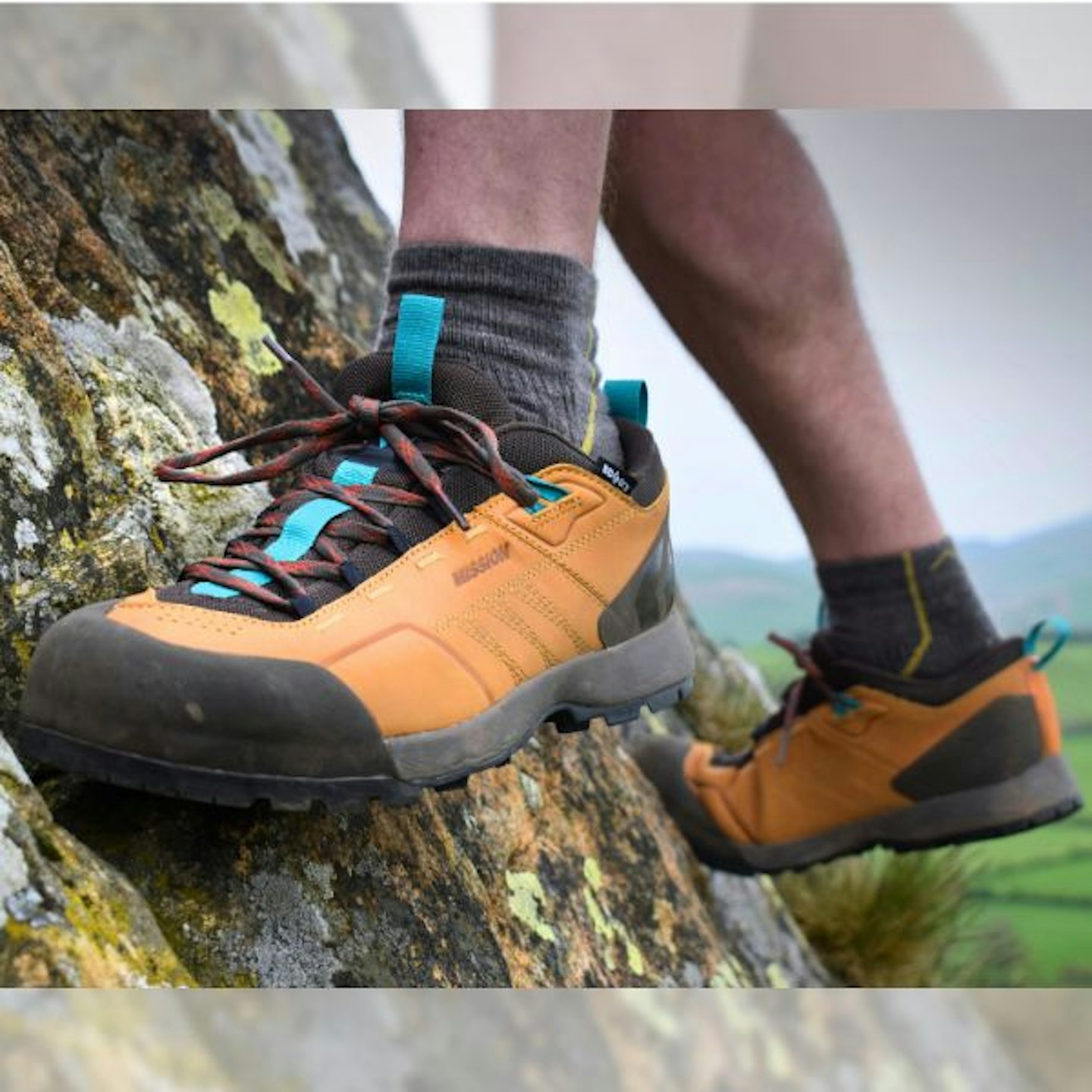 Live For The Outdoors
Live For The OutdoorsThis approach shoe is well-priced, durable, supportive and protective, featuring a grippy outsole and a breathable waterproof membrane.
The outsole is Black Diamond’s in-house BlackLabel-Mountain sticky rubber compound. It delivers good traction. A climbing zone that wraps around the toe enables you to ‘edge’ along little ledges and small holds. The diamond-shaped lugs are pretty deep while an angled heel brake and midfoot shank are designed for via ferrata and ladders.
The upper is made from a high-grade nubuck leather, which combined with Black Diamond’s proprietary BD.dry membrane provides waterproofing. The tongue is gusseted and padded, and the all-round fit provides good levels of comfort.
There is lots of flex at the forefoot but the heel is stiff, and the general ‘feel’ of the shoe is moderately rigid. This ensures confidence and stability on scrambling terrain. A strong rubber rand at the toe and heel protects the foot, and improves durability.
At 435g this is the second heaviest shoe on test. The waterproofing, combined with the low cut, may struggle to cope with British bogfests. It also feels a little chunky, rather than precise, with a higher internal volume than some other pairs. Lacing could be more precise too.
Pros
- Well priced
- Durable
- Versatile outsole
Cons
- Relatively heavy
- Don’t feel especially precise
| Size range | Men's US6-14; women's US5.5-11 |
| Weight (per shoe) | 435g (men’s 9) |
| Women's version? | Yes |
| Upper | Nubuck leather |
| Outsole | BlackLabel-Mountain rubber |
| Waterproof lining | BD.dry |
Best lightweight approach shoes
 Live For The Outdoors
Live For The Outdoorswww.sportsshoes.com
Not all approach shoes are built equally. Some designs are far stiffer, narrower and more precise for performance on technical ground; others are softer, roomier and comfier with more flex for a better hiking experience. Which is best for you? It all depends on how vertical and technical your scrambling will be, and whether you’ll be mostly hiking with a touch of scrambling, or vice versa.
The Eldo GV falls into the lighter, comfier, less-rigid category of approach shoes. At 328g, it’s the lightest on test. It’s also the most flexible, with loads of bend at the forefoot, and the fit is more spacious than other pairs. This means the Eldo GV has the best comfort for hiking in our round-up – but it still performs pretty well on technical ground.
Features include a Gore-Tex waterproof liner, a PU wraparound rand and a grippy Asolo/ Vibram AG outsole with climbing zone. The climbing-style lacing is excellent too.
For more serious and technical scramblers, the Eldo GV will probably feel too light and flexible, with insufficient stiffness. This may be a dealbreaker for some. The fit doesn’t feel quite as precise as some pairs either, meaning your ‘groundfeel’ is slightly compromised.
Pros
- Lightweight
- Comfortable for longer walks
Cons
- Not best suited for the most technical scrambles
| Size range | Men's UK7-12.5; women's UK4-8 |
| Weight (per shoe) | 328g (men’s 9) |
| Women's version? | Yes |
| Upper | Polyester |
| Outsole | Vibram MegaGrip |
| Waterproof lining | Gore-Tex |
Best for foot protection
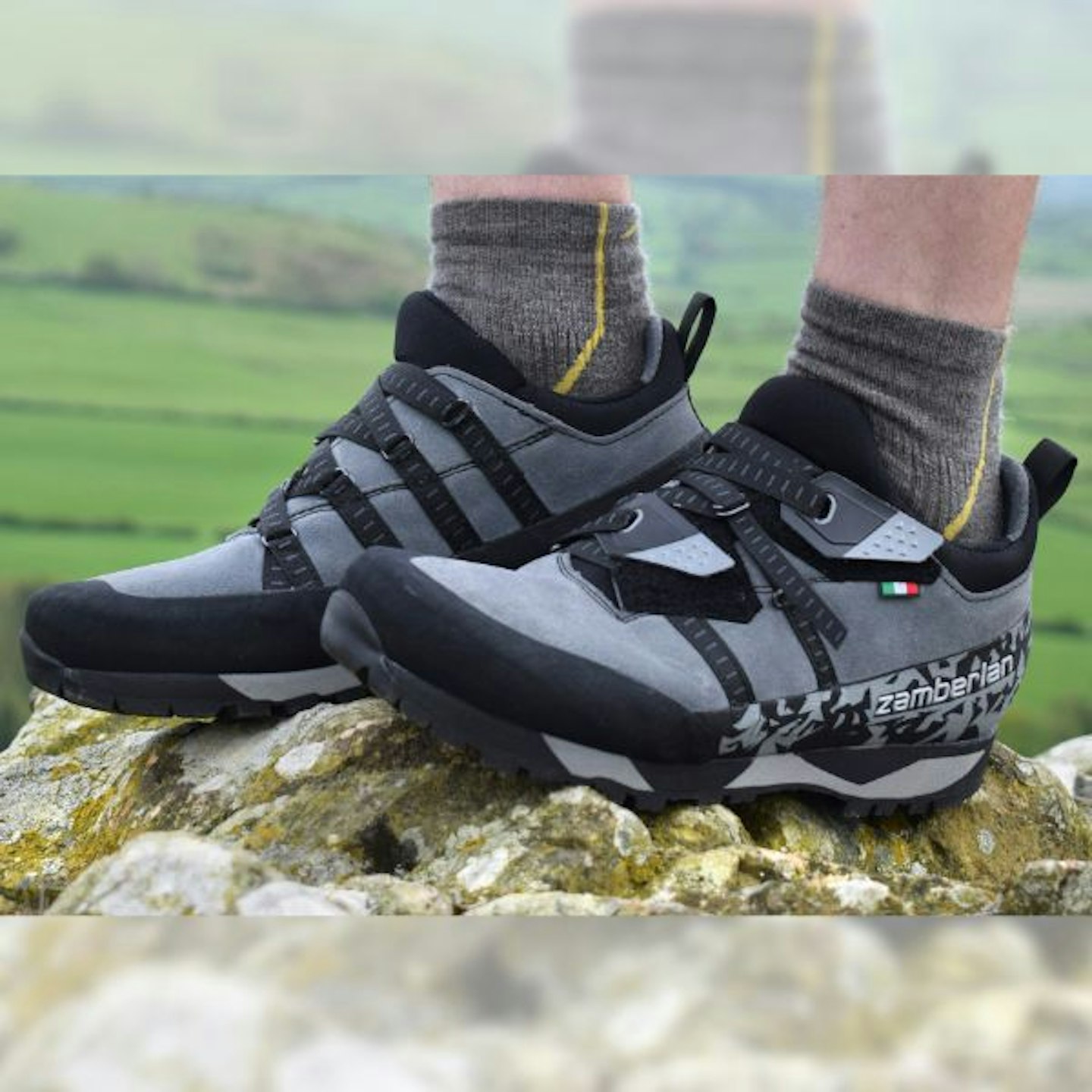 Live For The Outdoors
Live For The Outdoorszamberlan.co.uk
This shoe has some excellent features. The 360° wraparound rand is very strong and solid, providing top-notch protection for the suede leather upper. The inner has a bootie-style, sock-like design, featuring a stretchy tongue integrated into the collar. This is cosy and snug, without feeling restrictive, and in general comfort levels are high.
The Vibram Pepe outsole is grippy with pretty deep lugs, and special zones at the toe and heel are provided for technical manoeuvres such as edging. There is a tiny bit of flex at the forefoot, but overall this shoe is very stiff and rigid for bombproof stability on rocky terrain.
But the standout feature is the lacing set-up, featuring a combo of Velcro and hook-and-loop fasteners. The idea is you can customize the volume and tension of the fit to your foot shape by adjusting one strap. We found it a little fiddly and weren’t ‘wowed’ by it, but it worked fine.
There is no women’s specific version, although the shoe is considered unisex. The distinctive lacing system is rather odd, and is likely to polarise opinion. At 447g it’s the heaviest shoe on test. The Velcro can annoyingly accumulate bits of vegetation when you’re walking.
Pros
- Very grippy
- Class-leading foot protection
- Comfortable
Cons
- Unique lacing won’t suit everyone
- Relatively heavy
| Size range | Unisex EU38-48 |
| Weight (per shoe) | 447g (size 43) |
| Women's version? | No |
| Upper | 1.8-2mm Hydrobloc suede |
| Outsole | Vibram Megagrip |
| Waterproof lining | Hydrobloc leather |
Best all-rounder
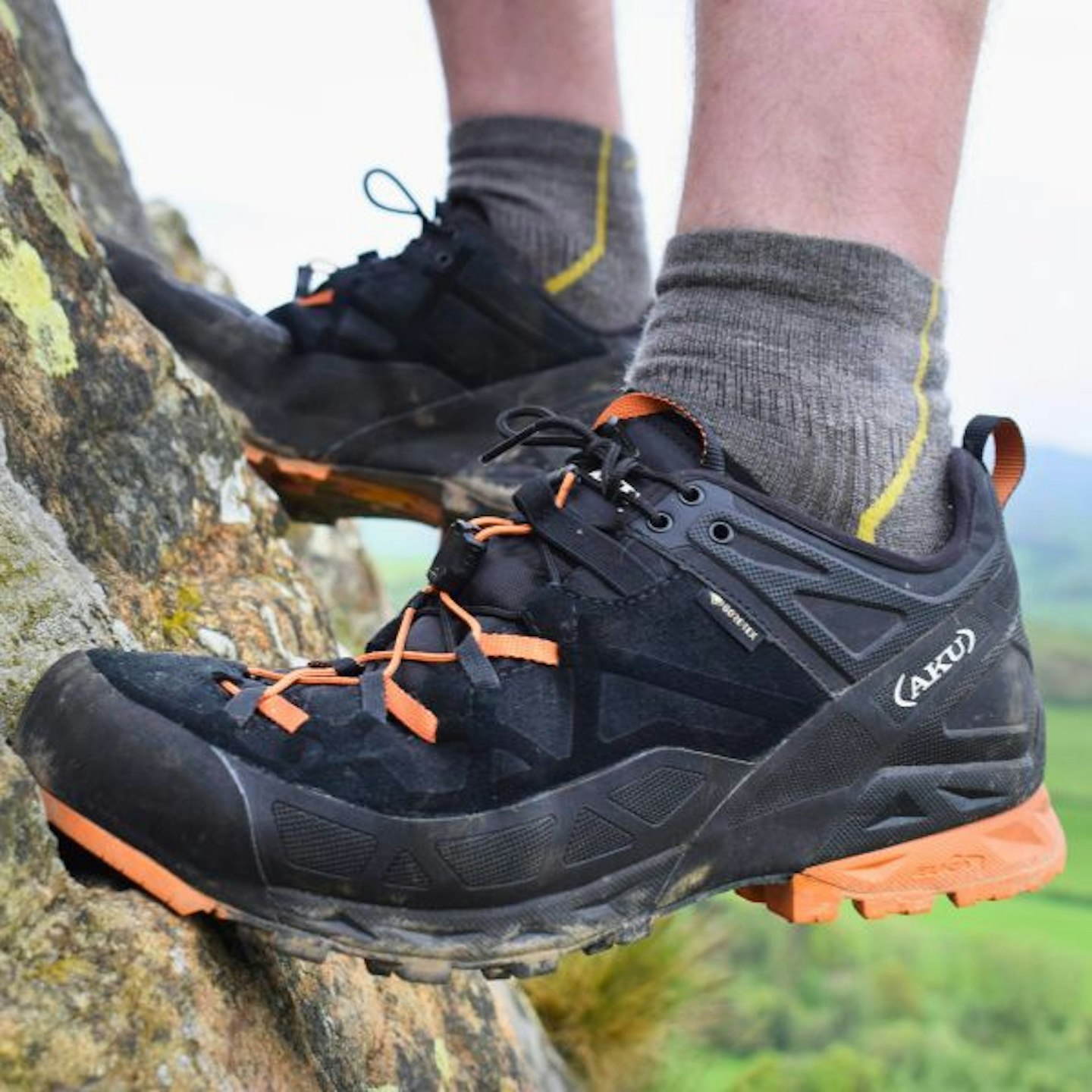 Live For The Outdoors
Live For The Outdoorswww.alpinetrek.co.uk
Dolomites-based brand AKU makes first-rate footwear with typical Italian craftsmanship, and the Rock DFS is no exception. It’s an excellent approach shoe: fully featured and technically proficient, striking a nice balance between comfort, support, protection and performance.
A big flaw in the whole approach shoe market is that the better a shoe is for climbing, the more uncomfortable it’ll be for hiking. AKU have a solution however. The Rock’s ‘dual fit system’ is a double lacing system, with both normal laces and ‘quick-laces’ (similar to those used on some running shoes). Use the normal laces for a looser, comfier hiking fit; tighten the quick-laces for a precise, snug fit for climbing sensitivity. The best of both worlds in one shoe.
Features include a 360° rand, a super-grippy Vibram Approcciosa outsole, a 1.6mm suede upper with air8000 mesh panels, a Gore-Tex liner, and a stiffened heel cup. Overall stiffness is moderate, with lots of flex at the forefoot.
It almost won our Best in Test award, but was let down by the high price tag. This is a lovely approach shoe, but it’s difficult to justify its significant price hike over its competitors.
Pros
- Adept at walking and climbing
- Excellent comfort
Cons
- Hardly the best value
| Size range | Men's UK4-13; women's UK3-8 |
| Weight (per shoe) | 418g (men’s 8.5) |
| Women's version? | Yes |
| Upper | 1.6mm suede, microfibre, air8000 |
| Outsole | Vibram Approcciosa Megagrip |
| Waterproof lining | Gore-Tex |
How to buy the best approach shoes
Upper: Approach shoes have synthetic or leather uppers. The former are lighter while the latter are tougher. For added durability, consider a wraparound rand. Whether or not the shoe is waterproof comes down to personal preference.
Sole: As approach shoes are intended for scrambling and climbing they are stiffer than hiking shoes. But while some approach shoes are quite stiff, others offer more flex. If you want them mainly for the climb, opt for a stiffer sole; if you do a reasonable amount of walking too, consider an option with greater flex.
Grip: Inspect an approach shoe’s lug pattern to see if it’s appropriate for your requirements. Deeper lugs and aggressive heel brake are ideal for soft and steep terrain. Also look at the climbing zone at the toe. A larger climbing zone around the entire toebox compared to just a portion of it will of course aid your climbing.
Fit: Finding the correct size of approach shoes should follow the same method as your other outdoor footwear. The fit should be secure, but with enough room to allow for swelling and making sure toes aren’t squished at the end when walking downhill.
Care and maintenance
To prolong the life and performance of your approach shoes, you need to clean them properly. Using the same materials as hiking boots and shoes. You can therefore care for them using the same easy method we discuss in our hiking footwear care guide.
It’s also important to check if your approach shoes can be re-soled. Those that can have a much longer and more sustainable lifespan than those that don’t. It also increases the long-term affordability of your footwear.
How we tested
Our reviewer, James Forrest, did a lot of walking and scrambling to determine the abilities of the approach shoes in question. We wanted to find out which ones excelled at climbing and which were best at balancing that with walking comfort. This, in addition to other factors such as build quality and value.
About the author
James Forrest is a freelance gear tester for Live For The Outdoors and Trail magazine. He’s a prolific peak-bagger and wild camper who’s climbed hundreds of mountains in the UK and abroad, James gives his gear a serious thrashing on every trip.
